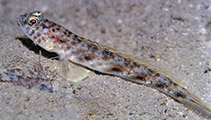| Family: |
Gobiidae (Gobies), subfamily: Gobiinae |
| Max. size: |
7.5 cm SL (male/unsexed) |
| Environment: |
reef-associated; marine; depth range 10 - 25 m |
| Distribution: |
Western Pacific: Japan, Guam, New Guinea, and the Great Barrier Reef. |
| Diagnosis: |
Dorsal spines (total): 6-7; Dorsal soft rays (total): 12-12; Anal spines: 1-1; Anal soft rays: 12-12. Characterized by pale grey to whitish body color; several large brown spots on middle of side; back and side interspersed with brown mottling; posterior margin of first dorsal fin with pair of pale-edged black spots; united pelvic fins, well developed frenum present; longitudinal scale series 54-58; posterior body with ctenoid scales, becoming cycloid anteriorly; head without scales; greatest depth of body 5.5-6.4 in SL; lanceolate caudal fin, a little longer than head length; reduced posterior oculoscapular sensory canal, single pore (H') present (Ref. 90102). |
| Biology: |
Inhabits fine carbonate sand bottoms of well-protected lagoons (Ref. 37816). Found in coastal bays and estuaries on sand or muddy substrates to 25 meters depth (Ref. 48637). Also found in lagoons and sheltered bays in 10-25 m (Ref 90102). |
| IUCN Red List Status: |
Least Concern (LC); Date assessed: 06 April 2022 Ref. (130435)
|
| Threat to humans: |
harmless |
Source and more info: www.fishbase.org. For personal, classroom, and other internal use only. Not for publication.

